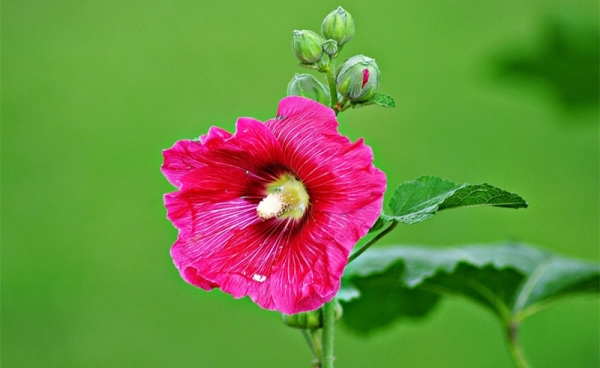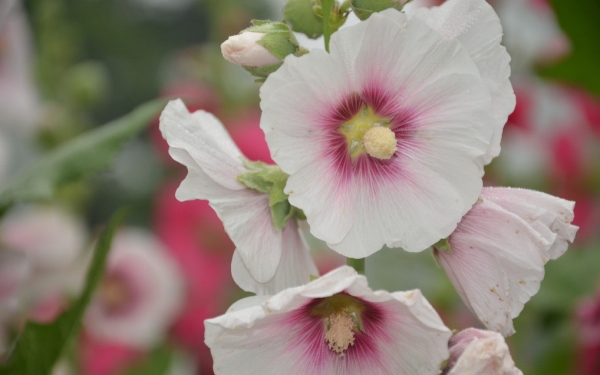Culture methods of hollyhock
soil
Althaea has strong saline-alkali tolerance, so it is best to plant it in loose, fertile and sandy soil with good drainage.

watering
Althaea requires more water during flowering. We need proper watering to keep the soil moist and promote the extension of flowering.
temperature
The optimum temperature for hollyhock growth is 25 to 30 degrees Celsius and 26 to 28 degrees Celsius during flowering. If the temperature is too low, it will affect the flowering of hollyhocks and even lead to poor growth of hollyhocks.
fertilization
During the seedling period of hollyhock, attention should be paid to fertilizing, removing and loosening soil to make the plant grow healthy. After flower bud formation in leaf axils, phosphorus and potassium fertilizer should be applied, and several leaves at the base should be cut off slightly.
What else do we need to pay attention to when raising hollyhocks?
Culture method of hollyhock
Althaea cultivation management is relatively simple, seedlings grow 2 to 3 true leaves, should be transplanted once, increase plant spacing. After transplanting should be timely watering, before flowering combined with intertillage weeding topdressing 1 to 2 times, topdressing with phosphorus, potassium fertilizer is good. After transplanting once, the seedlings can be planted in November. Seedling growth period, apply 2-3 times of liquid fertilizer, mainly nitrogen fertilizer. At the same time often loose soil, weeding, in order to facilitate the growth of healthy plants.
When the leaf axils of hollyhocks form flower buds, apply phosphorus and potassium fertilizer once. In order to prolong flowering, sufficient water should be kept. After flowering, the above-ground part is cut off in time, and new buds can also sprout. When potted, should be in early spring on the pot, keep this flower alone. Because the seeds of hollyhock are easy to scatter after maturity, they should be harvested in time. After 3-4 years of planting, the plants are easy to senescence. It should therefore be updated in a timely manner. In addition, hollyhock is easy to cross, in order to maintain the purity of varieties, different varieties should maintain a certain distance interval. Althaea susceptible to leaf rollers, aphids, red spiders and other hazards, old plants and dry weather rust disease, should be timely control.
Culture method of hollyhock
Hollyhock, also known as red. Perennial root herb of mallow family. Native to Southwest China.
1. Plant erect, up to 2M tall, unbranched, stems and leaves hairy. Leaves are large, nearly round or heart-shaped palmate, often 5 ~ 7 lobed, leaf surface rough, uneven, petiolate, raceme single leaf axil, flower diameter 7 ~ 9 cm, color has white, yellow, red, purple, ink purple and compound color. Flower form has single valve, compound valve, double valve kind, fruiting disc shape, seed kidney shape.
2-Growth habits like warm, cool climate, ground stem died in case of frost, rhizosphere tiller bud can overwinter. Sunny, slightly shade tolerant. Suitable soil layer is deep, fertile, good drainage soil, have self-propagation ability.
Breeding methods are commonly used to sow breeding, at 15. (: 15 ~ 20 days after germination, autumn seedlings bloom in the following year, spring seedlings often do not bloom in the same year, the next year can bloom. Also can use the tillering bud of rhizosphere to make ramet plant or cuttage propagation, this method can maintain the fine character of female parent, wait like double petal kind, rare flower color.
Cultivation and maintenance of hollyhock robust growth, extensive management, often used as wildflower cultivation, once planted, can be self-propagating growth every year.
Pest control There are few pests and diseases in hollyhock flowers, and even if pests and diseases occur, they will not endanger death. The pests to be controlled are:
Cinnabar mite: often occurs in late May, when there are many gray spots on the leaves, mites are mostly harmful on the back of the leaves. The occurrence period can be controlled by spraying 1 000 ~ 1 500 times solution of 40 "dicofol emulsifiable concentrate or 1 500 times solution of 4 cm dimethoate emulsifiable concentrate.
Cotton leaf rollers: commonly known as leaf rollers. Larvae will roll leaves into a tube and dive into the drum to eat leaves, serious when the leaves can be eaten up, leaving only thick and hard veins. Most of them occur in mid-June, late July and late August. Prevention and control methods: ① A small number of occurrences can be artificially killed.
(2) spraying 2 500 times solution of 50 phoxim emulsifiable concentrate for control. In addition, aphids (Aphis gossypii) may occasionally occur, and their natural enemies can generally inhibit their serious damage.
Horticultural use hollyhock flowers large, colorful bright, flowering longer, is an ideal background, barrier and home before and after the decorative material, can also be used as fresh cut flowers. In addition, the flowers, seedlings, roots and seeds of hollyhock can be human medicine, sweet and cold, with the effect of clearing heat and cooling blood, diuresis, etc.
- Prev

Propagation methods of hollyhock
Sowing and propagation of hollyhock are mainly carried out by sowing and reproduction. we generally choose to carry out in autumn, select fertile soil, and apply rotten compost in the soil as base fertilizer, sow the seeds, water to keep the soil moist, and take good measures to keep the soil moist in winter. it can take root and sprout in spring.
- Next

Control methods of diseases and insect pests of Achyranthes bidentata
Control methods of diseases and insect pests of Achyranthes bidentata
Related
- Fuxing push coffee new agricultural production and marketing class: lack of small-scale processing plants
- Jujube rice field leisure farm deep ploughing Yilan for five years to create a space for organic food and play
- Nongyu Farm-A trial of organic papaya for brave women with advanced technology
- Four points for attention in the prevention and control of diseases and insect pests of edible fungi
- How to add nutrient solution to Edible Fungi
- Is there any good way to control edible fungus mites?
- Open Inoculation Technology of Edible Fungi
- Is there any clever way to use fertilizer for edible fungus in winter?
- What agents are used to kill the pathogens of edible fungi in the mushroom shed?
- Rapid drying of Edible Fungi

